AMAZING SPIDER-MAN #23
 “The Goblin and the Gangsters”
“The Goblin and the Gangsters”
Script: Stan Lee
Art: Steve Ditko
Letters: Artie Simek
IN A NUTSHELL
The Green Goblin informs the mob that he will take over the criminal underground, inciting a gang war. Meanwhile, Peter drops by the Bugle and notices a letter on Betty’s desk from Ned. While there, Peter learns that JJJ has rehired Frederick Foswell, recently released from prison. Later, Spidey tracks down the Goblin, who leads him into a trap set by gangsters. Spider-Man fights the gangsters and the Goblin, who escapes. Soon after, Goblin learns that the cops, tipped off by Foswell, arrested the gang, leaving him without an army.
WHAT’S HOT
JUST DRAWN THAT WAY. Lucky Lobo looks like Dean Martin. maybe because I was already in a mindset to find pop culture connections, but isn’t there something about the Green Goblin that reminds you of…Phyllis Diller? See below.
LAUNDRY DAY. The writers tease us with the expectation that justice will suffer due to the inconvenient realities of life, when Peter has to launder and leave his Spider-Man suit hanging up to dry in the attic. There may be a slight hiccup in the story, but in the end, all turns out well. Still, we’re left to wonder…but what about next time??
MY BABY, HE WROTE ME A LETTER? Peter sneaks a peek at a letter from Ned to Betty and immediately suspects the worst. His angst is furthered when Betty doesn’t mention the letter. Oh, cruel world! Could this be the end of Peter and Betty? Yet, Stan gives us insight, when Betty’s thought bubbles read, “Oh dear! I forgot to tell him about Ned’s letter! Well, it’s too late now! I’ll mention it to him some other time!” Stan is teasing again—but this time he’s teasing Peter, who looks the Fool in Love.
WHAT’S NOT
HOODS & MASKS. Mostly this is just another story about costumed crusaders engaging with gangsters. The plot is merely a weak skeleton upon which to hang the personal perils of Peter Parker. Sadly, Spider-Man could be doing so much more…
ESCAPE HATCH. Hmmm…how to get out of this one? Goblin has used up all his bombs at the precise split-second that Spidey runs out of web fluid. If not for this timely coincidence, this battle could have gone on endlessly!

STRANGE TALES #131
 “The Bouncing Ball of Doom!”
“The Bouncing Ball of Doom!”
Script: Stan Lee
Pencils: Bob Powell
Inks: Dick Ayers
Letters: Sam Rosen
IN A NUTSHELL
The Mad Thinker is enraged when his latest plan is thwarted by Torch and Thing, so he accelerates his months-long scheme to create an ultimate weapon: a computerized metal ball that is impervious to fire and pressure. He lays a trap with the ball at a new dam and invites Thing & Torch to the opening. But Thinker miscalculates, and the ball damages the dam. To prevent further damage, Thing bats the ball into the upper atmosphere, where Torch uses his near nova blast to destroy the ball, leaving the Thinker to rant in despair.
WHAT’S HOT
INNOVATION. I guess it’s tiresome to always fight gangsters, villains and evil androids. Let’s get back to basics and spice it up a bit with a simple…BALL. (Or was this just an opportunity to give Bob Powell a little time off?)
RIGHT-O! The actions of the Bouncing Ball make me think of the Golden Snitch in a game of Quidditch.
WHAT’S NOT
GET TO THE POINT! What in blazes is going on here? By the end of page three, at least four different things have happened, but they’re either unrelated, or not going anywhere. Luckily, on top of page four, it’s all explained, because otherwise, I’m thinking, “I’m confused. I’m outta here.” It’s a shame that we are 1/4 of the way through, before the story begins to cohere.
EH… The Thinker hesitates with his cover story that he is “…eh…a reporter!” Didn’t think this through beforehand? Yet, the narrator hasn’t noticed this slight slip-up any more than Dr. Vega, reporting, “so calmly does the Mad Thinker speak…that Dr. Vega scarcely notices the unusual satchel.”
NOT AS ADVERTISED. The Mad Thinker tests the Ball and declares that it is the most fireproof object. Yet Torch destroys it with his “near nova heat blast.” I guess he didn’t THINK of THAT!

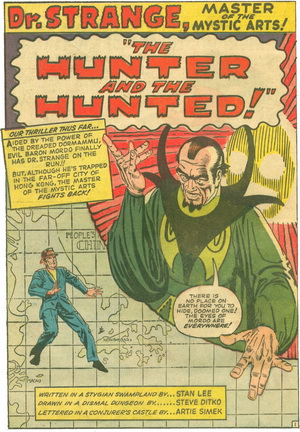 “The Hunter and the Hunted!”
“The Hunter and the Hunted!”
Script: Stan Lee
Art: Steve Ditko
Letters: Artie Simek
IN A NUTSHELL
While Doctor Strange hides in Hong Kong, Baron Mordo assures Dormammu that Strange will not escape again. Mordo sends his disciple to Hong Kong to track down Strange. The disciple rounds up a band of ruffians to scour the city. Meanwhile, Strange secretly secures a plane ticket out of the city. Mordo tracks Strange to the airport and sends an army of wraiths to capture him. On the plane leaving Hong Kong, Strange disguises himself as a wraith and signals to the other wraiths that he is NOT on the plane, allowing him to escape.
WHAT’S HOT
TRICKERY. Dr. Strange uses simple deception—no magic, spells or hypnosis—to get Mordo off his trail. Score one for Team Human Ingenuity!
SLY. Okay, so this month I’m obsessing over pop culture look-alikes. Here’s another: One of “Mordo’s men” could easily be played in the movie by Sylvester Stallone—if they ever made a movie of this story, which is unlikely, and if Stallone was willing to accept a bit part, which is even more unlikely. But hey…I’m just saying… Again, see below.
WHAT’S NOT
TITLE WASTE. Though a bit hackneyed, what a great title for a story: The Hunter and the Hunted. Such a shame though, that they wasted it on these few mostly forgettable pages.
MUCH ADO. This story is much ado about nothing. It’s a game of Cat and Mouse but nothing really happens. By the end, we’re right back where we started. The pace has slowed incredibly. Looks like we’re in for a loooong ride…

TALES OF SUSPENSE #64
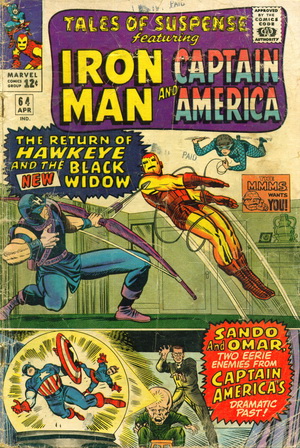 “Hawkeye and the New Black Widow Strike Again!”
“Hawkeye and the New Black Widow Strike Again!”
Script: Stan Lee
Pencils: Don Heck
Inks: Chic Stone
Letters: Sam Rosen
IN A NUTSHELL
While Tony Stark works to improve his armor, Black Widow, recently returned from Russia, reteams with Hawkeye to kidnap Happy & Pepper. Natash confides in Hawkeye that the Russians have threatened her with her parents lives. Iron Man races to rescue his friends, and when an acid arrow threatens to melt his armor, he feigns an attack on the Widow. Hawkeye abandons his attack to save Natasha, and the fight ends in a draw.
WHAT’S HOT
BAD IS GOOD. I like Black Widow and Hawkeye, partly because I know them as heroes in the Marvel Cinematic Universe, but also because they’re not actual villains—they’re more pseudo-villains, antagonists. In this story, they may be PRACTICING villainy, but in all they do, their motivation is love, not hate, not evil. This makes them much more three-dimensional “villains” than, say, Magneto or Dr. Doom.
MONKEY SEE, MONKEY DO. Black Widow uses the same tactic on Iron Man as the Russians used on her: kidnapping and holding loved ones hostage, in order to get him to do what she wants. She learned from the best!
LOVE ACTUALLY. In the end, when Hawkeye rushes to the injured Black Widow rather than sticking with the plan to destroy Iron Man, she laments, “Because of your love I’ve failed again!” In the end, Happy laments that Pepper still loves Tony, so what chance does he have? There is so much love going around, the narrator ends by practically apologizing to any readers who might be “thinking that you’ve been reading a romance mag by mistake…”
WHAT’S NOT
TONY WHO?? When Happy proposes to Pepper, he describes Tony as “Tony Stark”—just, you know, to distinguish from any of the other Tony’s who might have captured Pepper’s heart. (Tony Curtis? Tony Bennett? Tony the Tiger?)
OOO – When Tony Stark shows up at the rendezvous point, he claims that Iron Man is “out of town” and can’t be reached. What good is a bodyguard that you can’t reach? And what a lame excuse! At the very least, with only a moment more of thought, Stark could have said “Iron Man is on an Avengers mission.” That still doesn’t account for why he employs a bodyguard who can apparently only work odd hours part-time, but at least it provides a more detailed explanation for everyone there to latch on to. I call laziness on the part of the writer.
HANGING PLOT THREAD. In the last issue, Stark explains his long absence by saying he was off getting engaged to a Boston debutante. I am currently sitting on the edge of my seat to find out how he gets out of this one, but we’re not going there…yet. I hope this story will remain true to its soap opera roots and not slip into sitcom form, where suddenly everything that happened in the last episode is forgotten, and characters move on as if nothing ever happened.

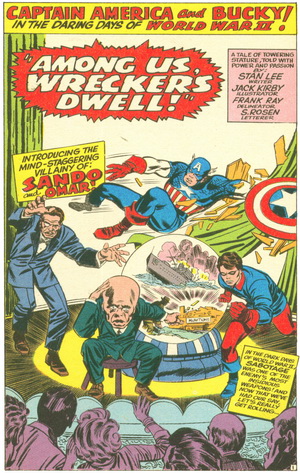 “Among Us, Wreckers Dwell!”
“Among Us, Wreckers Dwell!”
Script: Stan Lee
Pencils: Jack Kirby
Inks: Frank Ray
Letters: Sam Rosen
IN A NUTSHELL
Captain America and Bucky investigate when stage magician Omar’s prediction of a tank explosion at Fort Lehigh comes true. The next night, Omar and his partner Sando predict another military disaster, but the two heroes discover that Sando is actually a Nazi saboteur, and that the images Omar projects on stage are just smoke and mirrors. Cap and Bucky join forces with an agent of the women’s army corps to defeat Sando. When the WAC agent tells them that Sando had duped the innocent Omar, they release him.
WHAT’S HOT
GAL REPORTER. We meet a “gal reporter” in heels and shoulder pads. How very 1940’s Hollywood of them!
NOTHING IS AS IT SEEMS. Oops! Turns out she’s not a reporter at all, but a special agent working with the FBI. And Sando is not a mystic, he’s a Nazi colonel getting his orders directly from Hitler. Well, that one I actually saw coming, but it was nice to be in the room where almost no one was who they at first appear to be.
AT EASE, SOLDIER! I love the depiction of Private Rogers early in the story, hanging out in his wife-beater tee shirt and bucket hat, peeling potatoes as he listens to Bucky read the headlines. Cute.
WHAT’S NOT
PROPOGANDA. Stan is laying on the patriotism awfully thick when the special agent gal says, “He did it in order to make us lose confidence in our armed forces! But he didn’t know the American people!” Couldn’t be any more ham-handed if they used Thor’s hammer to drive home the point. I know overt propaganda like this was all the rage during WWII, but did it still fly in the mid 60s?

TALES TO ASTONISH #66
 “The Menace of Madam Macabre”
“The Menace of Madam Macabre”
Script: Stan Lee
Pencils: Bob Powell
Inks: Frank Ray
Letters: Sherigail
IN A NUTSHELL
Madam Macabre has designed a way to change the size of objects, and extends an offer to Giant-Man to team up to take over the world. When Hank declines, she takes her revenge by capturing Wasp. Giant-Man investigates Jan’s disappearance and discovers thieves stealing from a museum. When he gives chase, Macabre captures him and traps him in a shrinking room. Wasp escapes and fights Macabre. During the scuffle, she frees Hank, and the two heroes defeat Macabre.
WHAT’S HOT
TROLL. When Pym suggests making Madam Macabre a part of the team, he fully knows how Wasp will react. In keeping with their playful relationship, he’s just teasing her, trolling her. Nice touch!
EVERYBODY WANTS TO RULE THE WORLD…? When Giant-Man calls Madam Macabre’s offer “that corny ‘we can rule the world’ jazz,” it’s clearly a moment of self-deprecation on the part of the writer, and most satisfying to the reader.
CLEAN-CUT. Pym gets a crew cut, another step in the strip’s recent obsession with giving him a make-over. What’s next? Brylcreem? Aqua Velva?
TABBY HABIT. This is at least the second time the cat Tabby has made an appearance. I love that Hank and Jan have a pet, and that decades ahead of the “Real Men Love Cats” craze, the Marvel bullpen was not reluctant to go there.
WHAT’S NOT
GULLIBLE. When Jan gets a mysterious invite to an art exhibit asking her to wear her Wasp uniform under her clothes, she keeps dreaming up reasons for this to make sense and not be nefarious. Clearly, she has not been coffee klatching with Sue Storm, who could talk her ear off about how many FF adventures began with mysterious out-of-the-blue invites to public events.
TIME? When Jan gets to the art exhibit and is immediately chloroformed, Madam Macabre makes a point of saying that chloroform will keep her knocked out for at least ten minutes. Cut to Hank, worried because Jan has not yet called him (from her yet-uninvented cell phone?), so he goes after her and finds her…still asleep! None of this timing works out! It would have been fine, if Macabre hadn’t added in that little detail about “ten minutes.” Then there would be plenty of time for all of this to happen. So the next question obviously is: how long does a dose of chloroform last, anyway? Unfortunately, I don’t know, and I’m reluctant to add this search to my Google history, so for the time being, I’m just going to let this one go.
FALSE WALL. Madam Macabre’s henchmen devise a false wall to hide their art theft, so the night watchman won’t see them. But if the watchman makes his rounds, won’t he notice that the room is smaller by about 3-4 feet? I guess it depends on two things: one, how big is the room to start off with, and also, how much is that night watchman being paid?
CLEVERER. When you’re trying to sound menacing, it’s best not to include awkward words like “cleverer” to stumble over. It slows you down, deflates the seriousness of your threat, and makes your opponent wonder, “Now wait…wouldn’t it have been better for you to say ‘more clever’? Doesn’t that actually have more of a punch?”
SLANTED. Stan notes that they specifically “slanted” this story to give Jan more to do. In the 1960’s, you not only have to slant a story to make a woman important and relevant, but after you do, you need to crow about it!

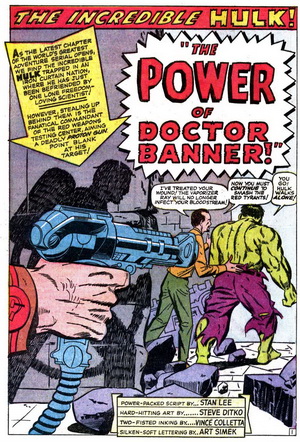 “The Power of Doctor Banner!”
“The Power of Doctor Banner!”
Script: Stan Lee
Pencils: Steve Ditko
Inks: Vince Colletta
Letters: Art Simek
IN A NUTSHELL
When the Commandant kills the scientist who had been protecting him, Hulk goes on the warpath. Meanwhile, in the United States, Maj. Talbot remains convinced that Bruce Banner has turned traitor, to Betty’s dismay. Elsewhere, in his secret lair, the Leader plots with Chameleon. He tracks Hulk to the Soviet Union, but decides to bide his time. Back in Russia, Hulk wipes out a strike force from the Soviet air force, then prepares for battle against a column of tanks.
WHAT’S HOT
WE ALL SEE IT…WE ALL SEE IT… The “credit block” on the splash always contains some little joke, usually about the letterer. In this story, the Power-Packed Script is by Stan Lee, Hard-Hitting Art by Steve Ditko, Two-Fisted Inking by Vince Colletta, and finally…Silken-Soft Lettering by Art Simek. It’s the same joke, over and over again, yet each time I pick up a new title, I look forward to reading the credit block, waiting for the punchline. It reminds me a lot of that British TV show, ’Allo ’Allo that I often watched with my dad during the last years of his life. It was the same hackneyed jokes over and over again, but we could see them coming, and Dad howled with laughter each time the predictable happened. The Marvel credit block is sort of like that.
WHAT’S NOT
DAMNED IF YOU DO, DAMNED IF YOU DON’T. I’m still baffled by the plot point that causes Banner to turn into Hulk when his blood pressure goes up…and then turns Hulk back into Banner when, once again…his blood pressure goes up! That doesn’t even make sense! Wouldn’t low pressure make more sense for the Hulk to Banner transformation? I just don’t get it…
MOST OF ALL. After considering the good his service could do to his country, Talbot adds, “MOST OF ALL, I must convince Betty Ross” of Banner’s guilt, “in order to win her love.” Really? Strikes me as odd that a military man charged with protecting state secrets is prioritizing his love life over all else. At one point he suggests he could resign his commission, and I’m thinking…yeah, maybe he should!
ALL OR NOTHING AT ALL. There are a lot of absolutes in this story. Army brass declares Bruce Banner must be “rescued…or silenced!” The Leader says Hulk must join him…or be eliminated. No middle ground. They might as well have printed this issue in black & white, because apparently those are the only options for the characters and the plot.
CONFIRMATION BIAS. While Betty is hopeful that there will be an “explanation” for Bruce Banner’s time behind the Iron Curtain, Talbot and Ross are more than ready to believe he is a spy. Don’t confuse them with any potential facts! Of course they would flatly deny jumping to conclusions. Like Buffy the Vampire Slayer, I can hear them both saying, “I didn’t jump. I took a tiny step, and there conclusions were.”
FOREIGNER. When the Commies can’t find Hulk, they think it’s impossible, since he is “so huge—with green skin—in a foreign land!” I understand huge and green skin as selling points, but how do they reason that being in a foreign land would make him easier to find?
NOT THE END. In the last panel, the narrator says, “Every tale must be concluded somewhere and we have come to the end of ours!” Beg to differ. Hulk has just seen a line of Commie tanks coming straight for him. This is not the end of one story, it’s the beginning of another. How disingenuous of Stan to say “we have come to the end.” A more honest assessment would’ve been, “We came to the end a few panels back, and now here’s a new event to hook you for the next issue.”

AVENGERS #15
 “Now, By My Hand, Shall Die a Villain!”
“Now, By My Hand, Shall Die a Villain!”
Script: Stan Lee
Layouts: Jack Kirby
Pencils: Don Heck
Inks: Mickey Demeo
Letters: Artie Simek
IN A NUTSHELL
While mailing a letter to Nick Fury, Captain America notices Executioner and Enchantress. He chases their car, but they escape. During an emergency meeting of the Avengers, Zemo’s agent captures Rick Jones and uses him as bait to draw the Avengers to Zemo’s South American hideout. Just as they are about to leave, the Masters of Evil—minus Zemo—attack, forcing Cap & Rick to go it alone, while the others battle in New York. Cap & Rick fight Zemo, leading to the villain’s apparent death in an avalanche.
WHAT’S HOT
CLOSURE. The narrator points out that some readers have complained that the Avengers “never wage a fight to the finish.” This comic delivers that now, when Captain America is present for the (apparent) death of Zemo. However, the jury is still out regarding the bulk of the Avengers, who continue their fight with other villains in NYC. So I may have more to report on this next month.
FORESHADOWING. Cap writes a letter to Nick Fury, offering his services to the military, as he seeks “full time work” beyond being an Avenger. Does this mean we are about to run into Nick Fury in the 1960’s timeline? Also, at the end, the narrator teases that in the next issue there may be a “change in line-up of the Avengers.” Really? Whoa! Way to sell those future issues!
WHAT’S NOT
UNATTRACTIVE WOMEN, PART I. I don’t like the artistic depictions of either Wasp or Enchantress in this issue. The only female who looks even moderately attractive is the stranger on the bottom of page two. Blake calls her a “pretty girl,” so I’m imagining extra care was taken in fashioning this depiction of this throw-away “extra.” Oh, if only they had taken the same care with the female characters who actually matter!
UNATTRACTIVE WOMEN, PART II. Perhaps the problem with both Wasp and Enchantress is that there are “too many cooks” spoiling the broth. With Kirby on layouts, Don Heck doing pencils and inks by Mickey Demeo, neither of them look anywhere near as attractive as I’ve seen them in past issues.
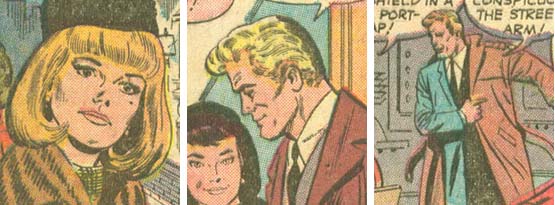
GOOD LOOKING GUYS. For the guys, though, it’s a completely different story! But…still there is a problem. On the top of page two, Henry Pym looks exactly like Steve Rogers on the bottom of the same page! Why not give each of these fine gentlemen some unique characteristics? Can you say “Control C, Control V”?
TEEN SIDEKICK IN THE PANTS. What earthly good is Rick Jones? I’ve decided his true purpose in the Marvel Universe is to get captured as a plot point.
NEWSREEL. We see a movie theater marquee proudly advertising the showing of a “Newsreel.” Is this some kind of joke? Perhaps an inside joke? Even in the 1960’s, did you ever go to a movie theater that publicly touted they were showing newsreels? Maybe that happened in WWII, before the advent of television. Are the artists once again showing their age? Is this movie theater soon to be flooded with high school boys wearing bow ties and hats?
A REALLY, REALLY BIG…SHOE? When Giant-Man’s hand comes down to crunch a car, his hand is so excessively large, that after a little calculation, I’m thinking he’s got to be 75-100 feet tall at this point. And if he’s that tall, and his hands are that large, then how big are his feet, and how does he even have room to stand up in a busy NYC street without causing damage? Never mind to bend down low enough to get that oversized hand onto the city street!
BLINDING ZEMO. Cap catches sunlight on his shield, temporarily blinding Zemo, who becomes “confused, bewildered, filled with fear,” causing him to wildly fire his disintegrator gun. Which sets off a rockslide. Which crushes him to death. Geez! If only Cap had known it was going to be this easy, he could have gotten rid of Zemo on any sunny day. Or even easier, he could have sent Wasp out there with her ever-handy makeup compact to get the job done.

FANTASTIC FOUR #37
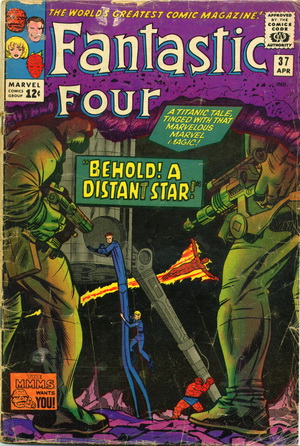 “Behold! A Distant Star!”
“Behold! A Distant Star!”
Script: Stan Lee
Pencils: Jack Kirby
Inks: Chic Stone
Letters: Artie Simek
IN A NUTSHELL
The Fantastic Four journey to the Skrull homeworld to seek justice for Dr. Storm, who was killed by the Skrulls. Morrat, a power-hungry Skrull officer, captures them and tells his girlfriend Annelle that he will turn them over to her father, the king (but he secretly plans to kill the FF and take the credit). When the king learns of Morrat’s treachery, he orders his forces to kill Morrat, but Annelle is also caught in the crossfire, saved only by Sue’s force field. In gratitude, the king reveals that it was Morrat who ordered Dr. Storm’s death.
WHAT’S HOT
WHAP! I always love it when the authors have a little fun at their own expense. After the Four lose their powers, Thing’s punch can only produce a “Whap!” and he laments that he “usedta never get anything less than a BAR-OOOM, or at least a KA-POWW!” I was amused.
NASA? When Reed mentions NASA, Stan feels the necessity to provide an explanatory asterisk. How quaint and nostalgic, a real reminder that these stories are taking place during the very beginnings of the American Space Age.
WHERE NONE HAVE GONE BEFORE. The Space Time Warp the Four must travel through to get to the Skrull planet seems a cross between my favorite childhood author, Dr. Seuss and my favorite TV show from the 80’s, Star Trek: The Next Generation.
EVIDENCE. It’s hilarious that Stan finds it necessary to offer photographic proof as “evidence”—then provides a full page of art. And not only that, but he apologizes for the picture being “a trifle hazy.” I don’t know about you, but none of this “evidence” is convincing me of anything.
WHAT’S NOT
I’M SORRY? Reed hears that Sue is upset and brings her flowers, but is unwilling to get close, choosing instead to stretch his arm across the room, almost as if he is afraid she may lash out at him. Does Sue have a temper? Did Reed do something to make her mad? Obviously he thinks that’s possible, since the first thing he says is “Have I done something?”
EXCUSES, EXCUSES…Maybe Sue isn’t ready to get married. She takes this opportunity, the day of her wedding rehearsal, to suddenly decide she can’t move forward until they get justice for her father, who was killed five issues ago.
BAD HAIR DAY. I’m not liking Sue’s new pageboy haircut. She’s looked a lot more attractive than this in the past. I hope she gets a new hairstyle before we see her in a wedding dress.
TWO-FER. In my last feature I talked about how awfully conveniently the writers sometimes tie up the plot with a neat little bow, and it’s definitely happening here. At the end of the story, after the King’s men kill Morrat and Sue saves Princess Anelle, the King most regally yet reluctantly tells the Four, “You may ask any boon of me!” All they want—the very reason they traveled to the Skrull planet—is to find Dr. Storm’s murderer. And what do you know? Turns out (at least according to the King), Morrat was the one responsible. And now he’s dead. So the King’s debt is paid, the FF get what they want, and now everyone can live happily ever after.
OUCH! Johnny creates a “vacuum spout” with “near Nova heat” to propel them from the bottom of the ocean to the heights of the Baxter Building. Question: wouldn’t being surrounded by “near Nova heat” fry you to a crisp? Or maybe, that’s only the case for us mere mortals…


 First, it appears that Zemo is dead. At least that’s what the authors want us to believe. Though we don’t actually see his body, we do see Cap standing over a gravesite that we have every reason to believe is Zemo’s. Later, when Rick Jones and Cap are talking together with no one else around, Rick says “Now that Zemo is dead…” So why would we think anything else?
First, it appears that Zemo is dead. At least that’s what the authors want us to believe. Though we don’t actually see his body, we do see Cap standing over a gravesite that we have every reason to believe is Zemo’s. Later, when Rick Jones and Cap are talking together with no one else around, Rick says “Now that Zemo is dead…” So why would we think anything else?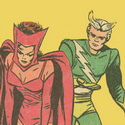 Now here’s another instance where my modern day experiences with the MCU are coloring my opinions about what I’m reading from 1965. This very month in X-Men, Scarlet Witch and Quicksilver finally break free from Magneto’s Brotherhood of Evil, and go back to Europe. Of course there’s no reason to believe a trip to Europe prevents these two from practicing their special skills. They say they’ll stop, but if you had skills like that, would you stop? I’m sure even back in 1965, every reader expected to see this brother/sister duo again. The only surprise here is that it happens so soon.
Now here’s another instance where my modern day experiences with the MCU are coloring my opinions about what I’m reading from 1965. This very month in X-Men, Scarlet Witch and Quicksilver finally break free from Magneto’s Brotherhood of Evil, and go back to Europe. Of course there’s no reason to believe a trip to Europe prevents these two from practicing their special skills. They say they’ll stop, but if you had skills like that, would you stop? I’m sure even back in 1965, every reader expected to see this brother/sister duo again. The only surprise here is that it happens so soon.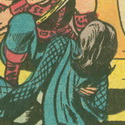 Now. What about Black Widow? In this issue, Hawkeye tells a story about how she was attacked by Commies and taken away in an ambulance. Hmmm…that doesn’t sound good. Then, to honor Black Widow, Hawkeye promises to “make up for what we’ve done.” That also sounds like something a survivor would promise on their beloved’s deathbed. But rather than risk hearing that Natasha has died, Hawkeye prefers to remain ignorant and maintain hope that she is still alive. Definitely no body, so surely she is still alive. Let’s put it this way: the jury is still out—but not in deliberation; they’ve just gone down the street for a cup of coffee and a sandwich.
Now. What about Black Widow? In this issue, Hawkeye tells a story about how she was attacked by Commies and taken away in an ambulance. Hmmm…that doesn’t sound good. Then, to honor Black Widow, Hawkeye promises to “make up for what we’ve done.” That also sounds like something a survivor would promise on their beloved’s deathbed. But rather than risk hearing that Natasha has died, Hawkeye prefers to remain ignorant and maintain hope that she is still alive. Definitely no body, so surely she is still alive. Let’s put it this way: the jury is still out—but not in deliberation; they’ve just gone down the street for a cup of coffee and a sandwich. 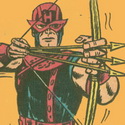 So what about Hawkeye? Where’s his head at the moment? When we last saw him, he was full of hate for Iron Man. There were mitigating circumstances, to be sure, but when push comes to shove, he and Black Widow were trying to kill Iron Man. And now Hawkeye wants to work with him? Why isn’t anyone suspicious? I mean, at least Iron Man should be questioning Hawkeye’s motives.
So what about Hawkeye? Where’s his head at the moment? When we last saw him, he was full of hate for Iron Man. There were mitigating circumstances, to be sure, but when push comes to shove, he and Black Widow were trying to kill Iron Man. And now Hawkeye wants to work with him? Why isn’t anyone suspicious? I mean, at least Iron Man should be questioning Hawkeye’s motives.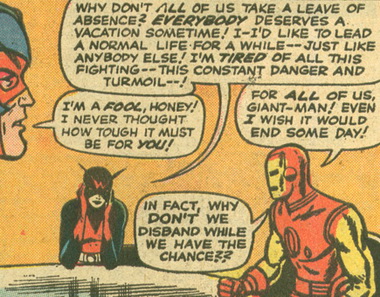
 I love love love that they ask Sub-Mariner to join. And I’m also not at all surprised that he turns them down. While Tony recognizes Namor as a noble antagonist, possessing the caliber of an Avenger, he also respects Namor’s decision, which is made “like the prince that he is.” Too bad…sort of. I would have liked to see Namor as an Avenger. Maybe I will someday? I don’t know. But I do know that at this point, he is not ready. There’s way too much domestic strife going on in his kingdom under the sea. Heroism begins at home. Maybe later, Namor?
I love love love that they ask Sub-Mariner to join. And I’m also not at all surprised that he turns them down. While Tony recognizes Namor as a noble antagonist, possessing the caliber of an Avenger, he also respects Namor’s decision, which is made “like the prince that he is.” Too bad…sort of. I would have liked to see Namor as an Avenger. Maybe I will someday? I don’t know. But I do know that at this point, he is not ready. There’s way too much domestic strife going on in his kingdom under the sea. Heroism begins at home. Maybe later, Namor? Iron Man tells the new Avengers their first order of business should be to track down Hulk and get him to join. I’m flabbergasted! What in the world makes Iron Man think Hulk will want to join the Avengers? He was with them before, but only for a brief time, and that did not end well. Since then, he’s spent all his time running away the military that’s been relentlessly pursuing him. Nothing has happened since Avengers #3 that would make us think he is suddenly interested in playing well with others. The big guy really just wants to be left alone. Don’t poke the bear!
Iron Man tells the new Avengers their first order of business should be to track down Hulk and get him to join. I’m flabbergasted! What in the world makes Iron Man think Hulk will want to join the Avengers? He was with them before, but only for a brief time, and that did not end well. Since then, he’s spent all his time running away the military that’s been relentlessly pursuing him. Nothing has happened since Avengers #3 that would make us think he is suddenly interested in playing well with others. The big guy really just wants to be left alone. Don’t poke the bear! 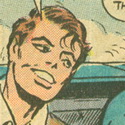 When Cap compliments Rick Jones for his loyalty to Hulk, for a moment I’m thinking, oh no! Please! We’re not really going to have to deal with Rick Jones as an Avenger, are we? The only superhero moniker I can imagine for him is Dead-Weight. Thank goodness, that didn’t pan out! As Rick himself laments, “And what am I? A fever blister?” Well, Rick, since you asked…
When Cap compliments Rick Jones for his loyalty to Hulk, for a moment I’m thinking, oh no! Please! We’re not really going to have to deal with Rick Jones as an Avenger, are we? The only superhero moniker I can imagine for him is Dead-Weight. Thank goodness, that didn’t pan out! As Rick himself laments, “And what am I? A fever blister?” Well, Rick, since you asked… people with a checkered past can ultimately be redeemed and do some good. Sometimes the reformed no-good-nik is exactly the best kind of person for a job like this. They have a lot to prove, both to others, and to themselves. And having been on both sides of the fence, they may have a deeper understanding of the complexities of both good and evil.
people with a checkered past can ultimately be redeemed and do some good. Sometimes the reformed no-good-nik is exactly the best kind of person for a job like this. They have a lot to prove, both to others, and to themselves. And having been on both sides of the fence, they may have a deeper understanding of the complexities of both good and evil. 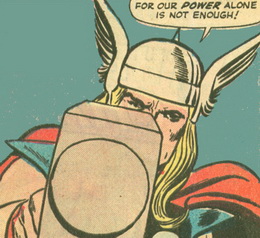 Iron Man, Giant-Man and Wasp give a Long Goodbye, but is it really “Goodbye,” “S’long”, or perhaps a simple “See ya later”? Are they indeed disbanding, taking a leave of absence, or just going on vacation?
Iron Man, Giant-Man and Wasp give a Long Goodbye, but is it really “Goodbye,” “S’long”, or perhaps a simple “See ya later”? Are they indeed disbanding, taking a leave of absence, or just going on vacation?
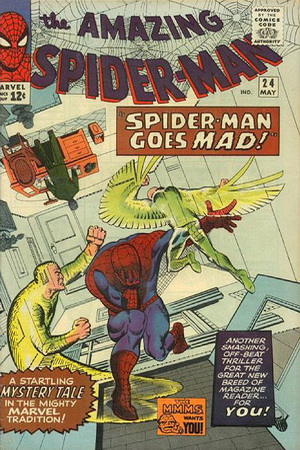
 PERSUASION
PERSUASION
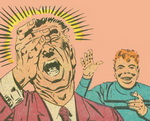 Having said all that, Jameson goes way beyond simple “spin.” His journalistic ethics are down the toilet. He consciously blurs the line between fact and opinion, moving beyond spin into outright falsehood. He deliberately uses the power of the press to mold public opinion against Spider-Man, regardless of the truth. When someone/anyone walks into his office purporting to be a “European expert” and spouting exactly what he wants to hear, Jameson makes no effort to vet the source, he just runs with the story. The Bugle is obviously a closer cousin to the National Enquirer than the New York Times.
Having said all that, Jameson goes way beyond simple “spin.” His journalistic ethics are down the toilet. He consciously blurs the line between fact and opinion, moving beyond spin into outright falsehood. He deliberately uses the power of the press to mold public opinion against Spider-Man, regardless of the truth. When someone/anyone walks into his office purporting to be a “European expert” and spouting exactly what he wants to hear, Jameson makes no effort to vet the source, he just runs with the story. The Bugle is obviously a closer cousin to the National Enquirer than the New York Times.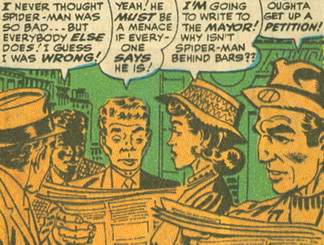 should be checking to see if this inflammatory rhetoric is backed up by any other
should be checking to see if this inflammatory rhetoric is backed up by any other  The poor boy’s self-esteem is suffering terribly, and he is more than willing to twist it all around to believe the worst possible outcome for him personally.
The poor boy’s self-esteem is suffering terribly, and he is more than willing to twist it all around to believe the worst possible outcome for him personally. 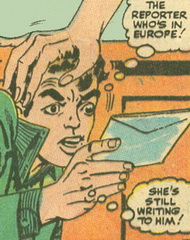 teenage psyche. If he hadn’t been so gaslighted by Jameson and the “European expert,” if he had been able to think more clearly, he may have realized that when he started seeing all his past opponents, Mysterio was not one of them…and oh, by the way, what are Mysterio’s powers? To make you see and hear things that aren’t actually there! Peter could have used his scientific powers of deduction to at least suspect Mysterio could be behind all this.
teenage psyche. If he hadn’t been so gaslighted by Jameson and the “European expert,” if he had been able to think more clearly, he may have realized that when he started seeing all his past opponents, Mysterio was not one of them…and oh, by the way, what are Mysterio’s powers? To make you see and hear things that aren’t actually there! Peter could have used his scientific powers of deduction to at least suspect Mysterio could be behind all this.  that will one day populate a multi-billion dollar entertainment empire, it’s not unreasonable to think that at some point in the future a 60-something year-old woman who once played with trolls while the boys in her class were reading comics, is now perusing and finding meaning in those very comics.
that will one day populate a multi-billion dollar entertainment empire, it’s not unreasonable to think that at some point in the future a 60-something year-old woman who once played with trolls while the boys in her class were reading comics, is now perusing and finding meaning in those very comics.  “The Goblin and the Gangsters”
“The Goblin and the Gangsters”
 “The Bouncing Ball of Doom!”
“The Bouncing Ball of Doom!”
 “The Hunter and the Hunted!”
“The Hunter and the Hunted!”
 “Hawkeye and the New Black Widow Strike Again!”
“Hawkeye and the New Black Widow Strike Again!”
 “Among Us, Wreckers Dwell!”
“Among Us, Wreckers Dwell!”
 “The Menace of Madam Macabre”
“The Menace of Madam Macabre”
 “The Power of Doctor Banner!”
“The Power of Doctor Banner!”
 “Now, By My Hand, Shall Die a Villain!”
“Now, By My Hand, Shall Die a Villain!”

 “Behold! A Distant Star!”
“Behold! A Distant Star!”
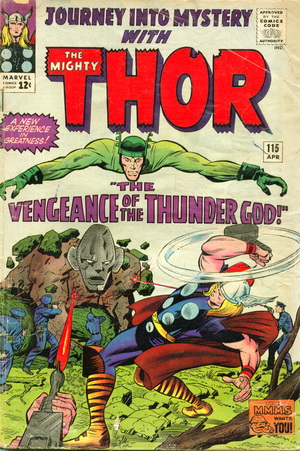
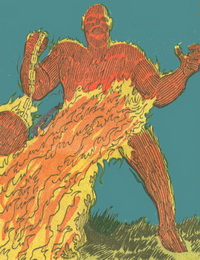 Perhaps “brainpower” is not one of those things he is able to absorb.
Perhaps “brainpower” is not one of those things he is able to absorb.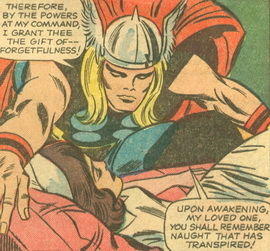 Also in this story, we learn that Thor has the power to cause Jane to forget what happened when she was whisked away to Asgard. I know I’ve seen this amazing power before (Giant-Man uses a serum on Second-Story Sam; with his mighty mind power, Professor X wipes clean the Blob’s memories). How awfully convenient for a superhero whose #1 imperative is to keep his identity a secret! How convenient…and what a cheat.
Also in this story, we learn that Thor has the power to cause Jane to forget what happened when she was whisked away to Asgard. I know I’ve seen this amazing power before (Giant-Man uses a serum on Second-Story Sam; with his mighty mind power, Professor X wipes clean the Blob’s memories). How awfully convenient for a superhero whose #1 imperative is to keep his identity a secret! How convenient…and what a cheat.  The early writers of these Marvel Comics are teetering on the edge of abuse of this power, much too quickly and conveniently writing themselves out of a hole, rather than facing the stark reality of figuring out how their characters might deal with difficult situations.
The early writers of these Marvel Comics are teetering on the edge of abuse of this power, much too quickly and conveniently writing themselves out of a hole, rather than facing the stark reality of figuring out how their characters might deal with difficult situations.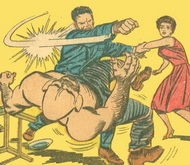 FULL FIVE MINUTES to leave…and THEN he’s going to call the police! Ooooh! I’ll bet that had the Absorbing Man shaking in his boots. John does in fact get off one good punch, which helps the situation for all of about five seconds. He doesn’t accomplish much as far as the storyline goes, but at least in the end, his wife is proud of him because he proved that he was “an Avenger in Spirit, and in Heart!”
FULL FIVE MINUTES to leave…and THEN he’s going to call the police! Ooooh! I’ll bet that had the Absorbing Man shaking in his boots. John does in fact get off one good punch, which helps the situation for all of about five seconds. He doesn’t accomplish much as far as the storyline goes, but at least in the end, his wife is proud of him because he proved that he was “an Avenger in Spirit, and in Heart!”  “A Viper in Our Midst!”
“A Viper in Our Midst!” might work out. But don’t count on their making any sacrifices for you. A house divided cannot stand. And there is no honor among thieves. Or for that matter, among any breed of villain, be they earthly or Asgardian.
might work out. But don’t count on their making any sacrifices for you. A house divided cannot stand. And there is no honor among thieves. Or for that matter, among any breed of villain, be they earthly or Asgardian.












